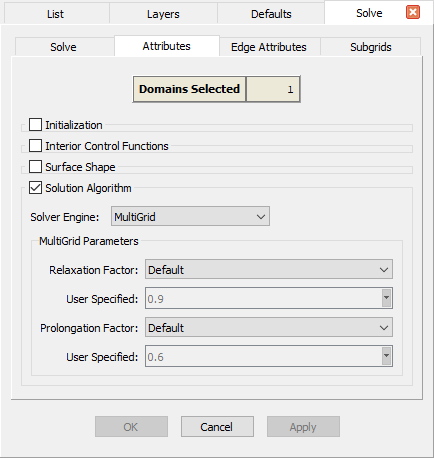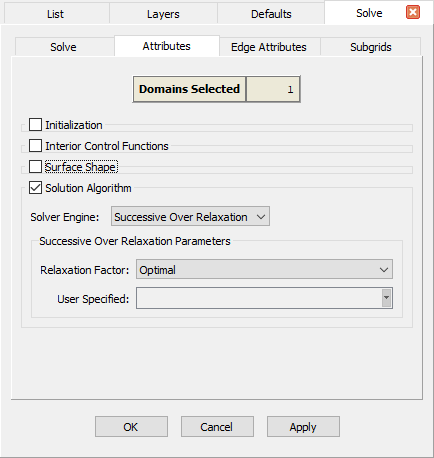Description
Fidelity Pointwise calculates the elliptic PDE solution on a grid using a successive over-relaxation (SOR) numerical algorithm with multigrid acceleration. This is an iterative method to converge upon the grid point locations that satisfy the elliptic PDEs.
The Solver Engine pull down list lets you choose between two possible solution techniques:
- MultiGrid: Solves the elliptic PDEs via a multigrid approach. With this method, solutions are obtained on the domain as well as on successively coarser representations of the same domain. The number of coarser levels used is dependent on the initial (fine) mesh size since the algorithm coarsens the mesh until the minimum dimension in any direction is 5. As the PDEs are solved on each of these meshes, the changes on the coarser representations are propagated to the finer meshes in a sequential manner that allows total solution convergence to be reached with a substantially smaller number of iterations than the Successive Over Relaxation method. This is the default method.
- Successive Over Relaxation: Uses an explicit, iterative method to compute grid point locations.
When MultiGrid is selected, the MultiGrid Parameters frame with two parameters is available. The multigrid algorithm relaxes the grid point solution iteratively on the selected grid as well as on coarser grids created by geometrically reducing the initial grid in all directions by a factor of 2. Two factors control how the multigrid algorithm will be applied to the initial and coarse grids, relaxation and prolongation. Relaxation Factor is used in the successive over-relaxation phase of the grid solution. The default value is 0.9. Values lower than the default will increase solution robustness but will require more iterations for convergence. Prolongation Factor is used in the prolongation phase of the grid solution in which the initial (fine) grid is updated with a percentage of the changes calculated on the coarse grids. If Delta is the change in a grid point's location on a coarse grid after a refinement sweep, then the grid point on the fine mesh is updated by adding omega * Delta to its original value, where omega is the prolongation relaxation factor. The default value is 0.6. Values lower than the default will increase solution robustness but will require more iterations for convergence.
When Successive Over Relaxation is selected, the Successive Over Relaxation Parameters frame is available. After each iteration, the grid point solution is "relaxed" according to the following choices for Relaxation Factor. Optimal applies a locally calculated relaxation which will be maximized at each grid point location. The Nominal choice uses a fixed value of 0.7 throughout the domain's points. Finally, User Specified allows you to type in a specific fixed value to use throughout the domain. This latter is very useful for setting lower values, for example 0.3, in those uncommon circumstances where a grid point location appears to oscillate between multiple solutions rather than settling to a single location. This can sometime happen for database constrained smoothing.

